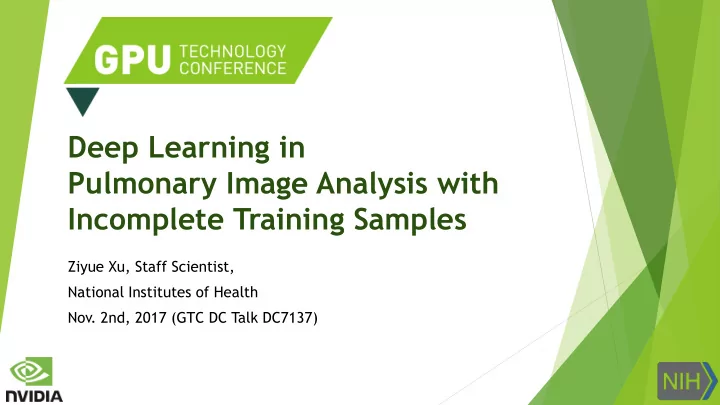

Deep Learning in Pulmonary Image Analysis with Incomplete Training Samples Ziyue Xu, Staff Scientist, National Institutes of Health Nov. 2nd, 2017 (GTC DC Talk DC7137)
Image Analysis Arguably the most successful application of deep learning Factors enabling deep learning’s success Computational power Learning algorithm Data availability Applications Cat Detection and classification Semantic segmentation Text-Image interrelationship modelling “A kitten lies on an opened book, seemingly reading”
Medical Image Analysis Similar tasks Computer-aided Detection and Diagnosis Organ/structure segmentation and measurement Joint report-image learning “There is a predominantly linear opacity in the paraspinal right lower lobe, adjacent to osteophyte formation within the upper thoracic spine (series X images XX). This is most consistent with a focus of atelectasis. …… There is a 5 mm subpleural left lower lobe nodule (series Y image YY). There are no pleural effusions. There is no pericardial effusion.”
Challenge for DL in Medical Image Analysis Algorithm: Computational power: to handle 3D volumetric data Learning algorithm design: selection of various network structures Data – major challenge: Public data availability: 14+ million ImageNet v.s. 1018 LIDC (largest CT image set for lung nodule) Image annotations: Most without annotation, few with labels, fewer of high quality Annotation uncertainty: Imaging heterogeneity, inter-observer variability, etc. What to do if we only have limited images?
To Address the Challenge from Data Patches instead of whole image Data augmentation with various transformations Transfer learning Pre-trained network as feature extractor + additional classifier Fine-tune pre-trained network All of the above are solutions for “making the best use” of existing labeled training samples, which are “not enough but good” for the task. What if we are not only limited by image amount, but also by incomplete labelling or no manual labelling at all – “not enough and not good”?
Examples – Pulmonary Image Analysis Tasks Reason for incomplete or no label: Too labor intensive Impossible to generate accurate ground truth Lung Segmentation: Airway Delineation: Lobe Estimation: ILD Labelling: Labor Intensive but Too Intensive Labor Feasible but Too Intensive and Feasible Sometimes Impossible Sometimes Impossible
Observation Compared with natural image, at “local” level (specific structure/organ), medical image tasks often feature 1. Less variability in shape / appearance / scene / etc. 2. Less contextual information, some tasks rely more on 3D information Cat Airway
Possible Solution Most tasks have been studied for decades and have sub-optimal solutions available Pathological lung: region growing, deformable models, etc. Airway: fuzzy connectedness, random walk, tracking, etc. Lobe: plateness enhancement + surface fitting, etc. ILD Patterns: handcrafted feature + random forest, etc. Postulation: Although incomplete, labels generated by former methods can be used to train a successful network for some tasks. Some tasks can be approached with weak labels.
Example 1 – Pathological Lung Lung: Large organ, limited 3D shape information Surrounding contextual information (rib cage, etc.) Multi-scale pathologies Segmentation: 2D whole image slice Progressive and multi-path holistically nested neural network Ground truth available
Result 0.985 DSC, compared with 0.966 from previous state-of-the-art methods
Example 2 – Airway Airway: Small structure, elongated Limited contextual information Segmentation: 3D local patch Ground truth unavailable: Use previous method to train Baseline labels highly specific but not sufficiently sensitive, A good representation can be learnt via such “incomplete label”
Result 3D-CNN learnt a better representation of the tubular airway structure than previous handcrafted features with the given samples Compared with baseline (red), new method results in 30 more branches detected, 5 more generations with 6 additional leakages in average
Example 3 – Lobe Lobe: Large organ, limited 3D shape information Surrounding contextual information (airway, vessel, etc.) Segmentation: 2D whole image slice 3D post processing Ground truth unavailable Thin fissure, sometimes invisible Reference truth contains errors
Result 2D Deep CNN enhanced the possible fissure structure 3D graph method further refined the precise location Better accuracy than current More accurate than training CT Training Prediction
Example 4 – ILD Patterns Image Patterns related to Interstitial Lung Diseases: emphysema, ground glass, micronodules, consolidation, honeycombing, reticular, etc. Medium/large area, limited 3D information, unclear boundaries with incomplete labeling: 2D, predict whole slice label – title / “weak label”
Result Ground truth – two datasets with incomplete label: Manual: roughly labeled a small portion of lung region (~ 10%) Automated: label all voxels, but without human check/correction Based on the training set, we predict the “major finding” for each slice CNN-F + multi-label regression + orderless feature description via Fisher Vector
Summary Data for medical image analysis tasks For certain tasks in medical image analysis, incomplete labels is feasible for training if it sufficiently covers the variance of target subject. Structure Selection Patch v.s. Whole Image Patch: generate many from a single scan, sacrifice contextual information Whole Image: all information, but limited by the number of training samples 2D v.s. 3D 2D: less computational power and resource needed, but lose 3D information 3D: structural information included, but limited by computational power
Thank you! Thank all our fellows and collaborators NIH Intramural Research Program NVidia for donating Tesla K40 GPUs! National Institutes of Health Clinical Center ziyue.xu@nih.gov
Recommend
More recommend